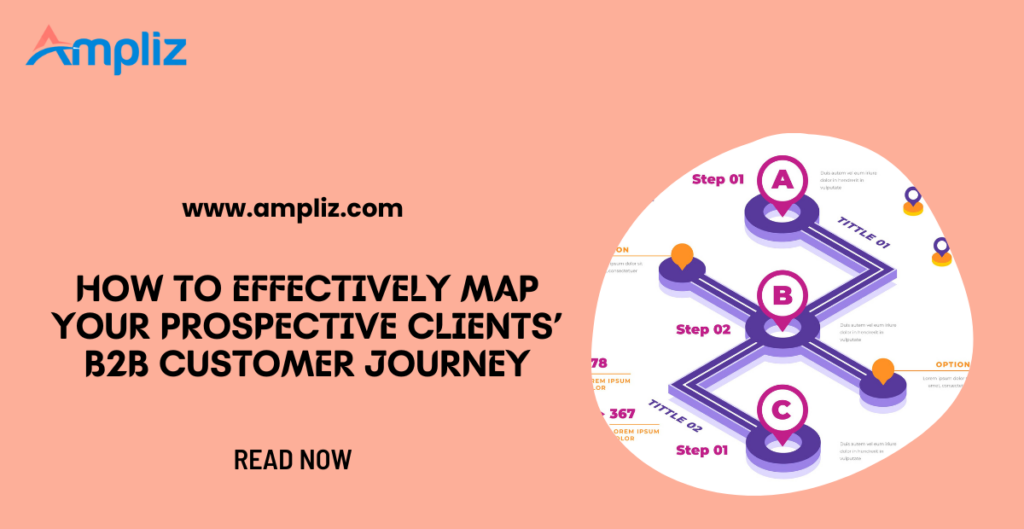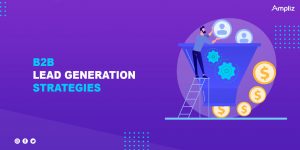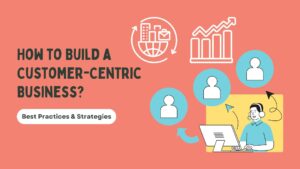According to TechJury, at least 73 percent of B2B buying decisions now rest in the hands of millennials. The landscape of business-to-business (B2B) interactions has truly evolved. While the statistic may be initially surprising, it underscores the pivotal role of mapping the B2B buyer’s journey.
Successfully navigating B2B transactions demands a meticulous approach, considering these exchanges’ highly interconnected and interdependent nature. In this article, we dive into the nuanced realm of B2B relationships.
If you’re a B2B enterprise owner, read on to learn how to effectively map your prospective clients’ B2B customer journey. We will highlight the importance of understanding B2B customer touchpoints and interactions, data analytics and intelligence, and buyer personas.
By mastering this process, you can foster enduring client relationships and clear the way for substantial B2B success.
An introduction to B2B customer journey mapping
In the competitive world of B2B enterprises, where relationships often determine success, mapping prospective clients’ paths is essential. Known as B2B customer journey mapping, this process is crucial to understanding and enhancing every interaction within the client lifecycle.
B2B customer journey mapping creates a visual framework of the stages, touchpoints, and critical interactions in prospective client engagement. It is a strategic process beyond mere awareness of the customer’s journey. It gives companies actionable insights into client behavior, preferences, and pain points. This holistic approach empowers organizations to tailor their sales and marketing strategies, improving the client experience.
Understanding B2B customer touchpoints and lifecycle
The B2B customer journey weaves a dynamic narrative, moving through various phases instrumental in forging lasting connections. Below are the phases contributing to the overarching story of B2B success:
Initial awareness
The B2B customer journey commences with potential clients learning about a business and its offerings. This stage is characterized by companies seeking solutions to address specific needs, often prompted by industry trends or emerging challenges.
Consideration
Detailed evaluations of various solutions take place, demanding businesses to articulate their value proposition clearly. It’s crucial to address pain points and distinguish themselves from competitors during this phase.
Evaluation and decision
This phase is a critical juncture where prospective clients narrow down choices and engage in in-depth assessments. Trust-building becomes pivotal during this phase. It requires businesses to provide comprehensive information, testimonials, and possibly demonstrations to substantiate offerings.
Purchase
This phase witnesses the formalization of transactions, the signing of contracts, and the conclusion of negotiations. Ensuring a smooth transition from prospect to client is crucial at this point, setting the tone for the relationship.
Implementation and onboarding
The focus shifts to delivering on promises, ensuring seamless integration, and providing necessary support. This stage significantly influences client satisfaction and the potential for long-term collaboration.
Post-purchase engagement and retention
This final phase involves ongoing communication, support, and efforts to exceed expectations. Fostering client loyalty and increasing the likelihood of repeat business is essential in this stage. This stage contributes to the overall success and sustainability of B2B enterprises.
Leveraging data for in-depth customer insights
Thanks to investments in data analytics, over 90 percent of organizations increased in measurable value in 2023. Data analytics is the process of collecting and analyzing large data volumes obtained from customer interactions.
Through this lens, businesses gain a comprehensive view of customer behavior, allowing them to identify patterns, trends, and anomalies. This granular understanding aids in predicting future actions and preferences, fostering a proactive rather than reactive approach to B2B relationships.
Customer segmentation
As a fundamental aspect of data analytics, customer segmentation divides the client base into distinct groups based on shared characteristics. This segmentation lets businesses personalize their interactions and offerings, creating a more targeted and effective engagement strategy. Recognizing the diverse needs and preferences within their B2B clientele allows companies to optimize their offerings and enhance customer satisfaction.
Predictive analytics
Forecasting future trends and customer behaviors based on historical data is known as predictive analytics. This foresight enables businesses to anticipate their clients’ evolving needs, allowing for real-time strategic adjustments and innovations. By anticipating market trends and client demands, B2B enterprises position themselves as industry leaders, fostering long-term partnerships.
Data-driven insights
Data-driven insights facilitate the development of customer journey maps. Understanding the touchpoints and interactions throughout the B2B customer journey allows businesses to refine their marketing, sales, and support strategies. By aligning these strategies with the preferences and behaviors revealed through data analytics, companies can optimize the entire customer experience.
Leveraging B2B data for in-depth customer insights is not only competitively advantageous but a necessity. Data analytics and intelligence empower businesses to decode customer behavior and preferences. This ability lets them customize their approach and anticipate customer needs.
Creating detailed buyer personas for B2B clients
Creating detailed buyer personas is a strategic process that involves crafting semi-fictional customer representations based on data. These personas go beyond mere demographic information. They delve into potential clients’ challenges, goals, and decision-making processes.
Aligning strategies with B2B buyer personas
Effective buyer personas are instrumental in aligning marketing, sales, and product development strategies with the target audience’s needs and preferences. In B2B enterprises, where purchasing decisions often involve multiple stakeholders, understanding each decision-maker’s motivations and pain points is crucial.
Buyer personas serve as a roadmap for tailoring messaging and offerings. They ensure resonance with the diverse individuals influencing the purchasing process.
Strategic steps in persona creation
To create detailed buyer personas for B2B clients, start with comprehensive research. This involves analyzing existing customer data, conducting interviews with current clients and stakeholders, and leveraging market research to gather insights.
Companies must identify commonalities in challenges, goals, and decision criteria to form the foundation of the personas.
Profile distillation and humanization
Once the research phase is complete, it’s important to distill the information into specific buyer persona profiles. These profiles should include details such as job roles, responsibilities, industry challenges, goals, and preferred communication channels.
Humanizing the personas is also vital. It can be done by incorporating personal preferences, communication styles, and potential objections they might raise during sales.
Collaborative efforts for holistic understanding
Collaboration among departments, mainly marketing and sales teams, is essential during persona creation. You can even include your external staff in the conversation, as they can offer a fresh perspective.
The insights gathered should be shared and discussed to ensure a holistic understanding of the target audience. This collaborative effort fosters alignment and ensures that marketing campaigns and strategies resonate with the varying needs of B2B clients.
Continuous refinement for dynamic success
Regularly update and refine buyer personas based on evolving market trends, customer feedback, and changes in the business landscape. Keeping personas current ensures that strategies remain relevant and effective in addressing clients’ ever-changing needs.
Creating detailed buyer personas for B2B clients enhances and maintains customer-centricity. They provide a detailed understanding of the target audience. This enables personalized and effective communication, ultimately driving success in a competitive marketplace.
The role of AI in B2B customer journey mapping
AI marketing global revenues are projected to reach $107.4 billion in 2028 from $107.4 billion in 2023. AI and machine learning play a transformative part in mapping the B2B customer journey. It enhances businesses’ ability to understand, predict, and respond to client behavior.
Data analysis for deeper insight
AI and machine learning technologies bring automation and intelligence to the process of mapping the B2B customer journey. It allows businesses to analyze vast datasets with unparalleled efficiency.
These algorithms sift through large volumes of customer interactions, uncovering patterns and trends that might be overlooked using traditional methods. The result is a more comprehensive understanding of the customer journey, empowering businesses to tailor strategies to meet evolving needs.
Strategic planning
Machine learning excels in predictive analytics, forecasting future customer behaviors based on historical data. Through machine learning models, B2B enterprises can anticipate the trajectory of a client’s journey, enabling real-time adjustments and strategic innovations. This proactive approach equips businesses to respond to dynamic market conditions.
Personalization for targeted experiences
AI and machine learning are crucial in personalization throughout the customer journey. By analyzing individual preferences, behaviors, and engagement patterns, businesses can deliver targeted and personalized content, recommendations, and interactions. This tailored approach fosters a deeper connection with clients at each stage of their journey.
Enhanced customer interactions with chatbots
AI-driven chatbots and virtual assistants contribute to improved customer interactions. These tools provide instant responses, address queries, and guide customers through their journey, enhancing the overall experience. The seamless integration of AI in customer interactions ensures efficiency and responsiveness, contributing to positive client perceptions.
Implementing effective communication strategies
In an Amazon survey, 99 percent of respondents said it’s important for a business to communicate effectively with customers. Implementing effective communication strategies is a cornerstone of successfully mapping the B2B customer journey.
In a landscape where relationships and interactions are pivotal, strategic communication can be the catalyst for building strong, long-lasting partnerships. Below are significant strategies to implement for effective communication throughout the B2B customer journey:
Understanding the audience
Effective communication begins with a deep understanding of the target audience. In the B2B sector, which involves multiple stakeholders, identifying and empathizing with each one’s needs, challenges, and priorities is crucial.
When making checking account offers, for example, a personalized approach often works for a small business owner. However, it may be ineffective for a multinational company CEO. Tailoring a B2B business’ messaging to resonate with these diverse perspectives ensures that communication is relevant and compelling.
Personalization at every touchpoint
Personalization is the main driver of effective B2B communication, whether through personalized emails, targeted content, or customized presentations. A personalized approach demonstrates a company’s dedication to knowing and meeting the unique requirements of its prospective clients.
Multi-channel engagement
B2B customers engage through various channels, from email and social media to in-person meetings. Implementing a multi-channel communication strategy allows a business to meet its audience where they are. Consistency across channels ensures a cohesive and seamless experience, reinforcing the brand and message.
Clear and transparent communication
A B2B business must clearly articulate its value proposition, pricing structure, and any other critical information. Transparent communication builds trust, a foundational element in fostering successful B2B relationships.
Timely and relevant messaging
Timing is crucial in the B2B customer journey. However, delivering the right message at the right time requires a careful understanding of the prospect’s journey. Through data analytics, B2B companies can send timely and relevant messages aligned with the prospect’s customer journey stage.
Feedback loops for continuous improvement
Establishing feedback loops is essential for refining and improving communication strategies. Actively seeking feedback from prospects and clients is a good way of knowing where improvements can be made. This iterative process ensures that communication strategies evolve with every client’s needs and preferences.
Needless to say, implementing effective communication strategies is integral to successfully mapping the B2B customer journey. With the above, a B2B business can develop meaningful connections and build trust with prospective clients.
Measuring and adapting: key metrics for success
Measuring and adapting are integral components of any successful B2B customer journey strategy. Identifying key metrics allows businesses to gauge the effectiveness of their approaches, enabling timely adjustments for optimal outcomes. Here are crucial metrics and the importance of continuous adaptation by B2B companies:
Customer acquisition cost (CAC)
A San Francisco, California-based thought leadership company studied 29 B2B companies recently. They found a combined average CAC of 85 percent for organic and 25 percent for inorganic efforts. A decreasing CAC suggests improved efficiency, while an increasing CAC may necessitate a re-evaluation of strategies and budget allocations.
Conversion rates
Conversion rates reflect the percentage of prospects taking a desired action, such as buying a product or requesting more information. Monitoring conversion rates at various customer journey phases offers insights into the effectiveness of marketing and sales strategies. Low conversion rates may indicate areas for improvement, prompting adjustments to enhance engagement and drive conversions.
Customer retention rates (CRR)
Retaining existing B2B clients is often more cost-effective than acquiring new ones. Monitoring customer retention rates helps businesses gauge satisfaction and the effectiveness of post-purchase interactions. A decline in retention rates may signal the need for enhanced customer support or personalized engagement strategies.
Net promoter score (NPS)
The NPS measures customer satisfaction and loyalty by gauging the likelihood of clients recommending a company to others. A positive NPS indicates satisfied clients who may become brand advocates, contributing to organic growth. Regularly assessing NPS provides insights into the overall customer experience and informs adjustments to enhance satisfaction.
Customer lifetime value (CLV)
The CLV is the total revenue a business can anticipate from a customer throughout their relationship. Monitoring CLV helps assess the long-term viability of customer relationships and guides decisions on resource allocation and customer engagement strategies. Increasing CLV often involves adapting approaches to enhance customer loyalty and satisfaction.
Feedback and survey responses
Direct feedback from B2B clients through surveys and responses is invaluable. Analyzing qualitative data provides deeper insights into customer experiences, preferences, and pain points. Regularly adapting strategies based on this feedback ensures alignment with client expectations and fosters continuous improvement.
Measuring and adapting in the B2B customer journey is an iterative process that requires a keen focus on key metrics. From conversion rates and acquisition costs to customer retention and satisfaction, continuous monitoring and adjustment are important for B2B success.
Mastering B2B with strategic customer journey mapping
Beyond client interactions, customer journey mapping serves as a compass for B2Bs working through the complexities of evolving markets. A well-crafted customer journey map not only aids in understanding customer needs but also unveils untapped opportunities for innovation. It acts as a proactive tool, allowing businesses to anticipate and adapt to industry shifts.
Moreover, the insights gleaned from comprehensive mapping can be leveraged to streamline internal processes, enhancing operational efficiency. Ultimately, pursuing sustained B2B growth and excellence is intrinsically tied to customer journey mapping as a vital, indispensable strategy.



